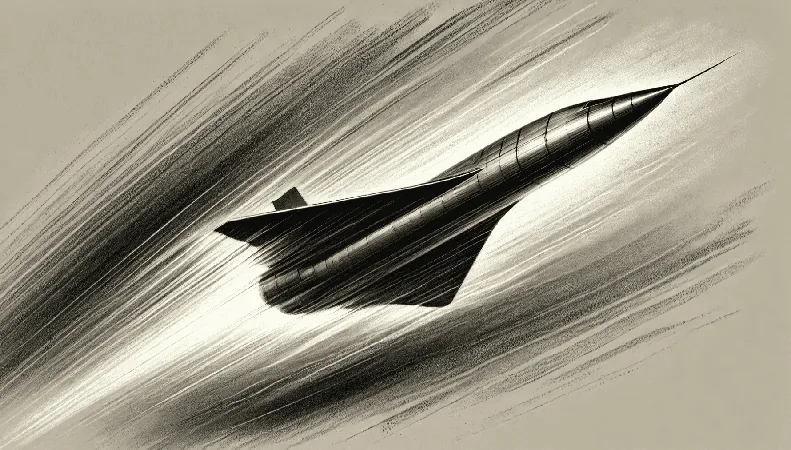
Chinese Scientists Pioneering Quantum Fluid Dynamics Could Propel Hypersonic Technologies Forward!
2024-11-06
Author: Wei Ling
Game-Changing Hybrid Methodology
The study introduces a groundbreaking algorithm known as the "Iterative-QLS" solver, which smartly combines error suppression techniques with quantum linear equations. This hybrid methodology allows for an unprecedented level of accuracy in fluid dynamics simulations, providing a vital foundation for more complex modeling in the future. Currently, traditional computational fluid dynamics (CFD) methods are hitting a wall due to their inability to manage increasingly complex simulations, particularly those relevant to high-speed travel. Hypersonic technologies, which operate at speeds exceeding Mach 5, present unique challenges, as they involve intricate interactions between shockwaves and turbulent airflow. The novel QCFD techniques explored in this study promise greater efficiency and precision, ultimately paving the way for more advanced aerospace designs.
Quantum Advances in Aerospace
Published in *Computer Methods in Applied Mechanics and Engineering*, this research emphasizes the potential impact of QCFD on hypersonic technologies. The team utilized superconducting quantum computers, capable of processing complex calculations much faster than conventional systems. Their innovative hybrid approach involves using quantum systems to tackle heavy computational loads while classical systems manage simpler tasks. Among the exciting findings, the researchers successfully simulated Poiseuille flow and acoustic wave propagation, fundamental phenomena in fluid dynamics, demonstrating remarkable accuracy. In tests, they maintained a relative error rate of less than 0.2% for the Poiseuille flow, showcasing the potential of quantum systems in handling complex computations.
Implications for Hypersonic Weaponry and Aerospace Engineering
The implications of these findings extend far beyond academic curiosity. The advancements could grant China a significant edge in the development of hypersonic weaponry, with their DF-17 missiles reaching speeds of Mach 10—ten times the speed of sound. The ability to accurately simulate and predict fluid dynamics at such extreme velocities is crucial for the design and efficiency of these systems. As the study highlights, enhancing computational fluid dynamics is essential for a variety of sectors, including aerospace, automotive, and maritime industries. With the growing limitations of traditional supercomputers, the capabilities unlocked by quantum computing could revolutionize product development cycles and minimize design costs.
Facing Limitations and Looking Ahead
Despite these promising advancements, the study does acknowledge significant limitations, chiefly the current constraints faced by quantum technology. The existing quantum computers still possess a limited number of qubits and are susceptible to errors—issues that researchers term the "noisy intermediate-scale quantum" (NISQ) problem. Nevertheless, the team is optimistic and aims to continue refining error suppression techniques to enhance the reliability of quantum simulations. Future directions may involve improved hybrid models and more sophisticated data exchange methods between quantum and classical systems. As quantum hardware continues to evolve, researchers anticipate a more significant ability to tackle complex simulations that could revolutionize not only hypersonics but also areas like climate science and advanced automotive engineering.
In summary, as China expands its endeavors in quantum fluid dynamics, the potential to redefine hypersonic technology and gain a competitive edge in global aerospace capabilities has never been more promising. The future of high-speed travel and advanced weaponry may very well lie in the quantum realm!







 Brasil (PT)
Brasil (PT)
 Canada (EN)
Canada (EN)
 Chile (ES)
Chile (ES)
 Česko (CS)
Česko (CS)
 대한민국 (KO)
대한민국 (KO)
 España (ES)
España (ES)
 France (FR)
France (FR)
 Hong Kong (EN)
Hong Kong (EN)
 Italia (IT)
Italia (IT)
 日本 (JA)
日本 (JA)
 Magyarország (HU)
Magyarország (HU)
 Norge (NO)
Norge (NO)
 Polska (PL)
Polska (PL)
 Schweiz (DE)
Schweiz (DE)
 Singapore (EN)
Singapore (EN)
 Sverige (SV)
Sverige (SV)
 Suomi (FI)
Suomi (FI)
 Türkiye (TR)
Türkiye (TR)
 الإمارات العربية المتحدة (AR)
الإمارات العربية المتحدة (AR)